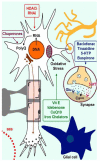Past, present and future therapeutics for cerebellar ataxias
- PMID: 20808545
- PMCID: PMC2866461
- DOI: 10.2174/157015910790909476
Past, present and future therapeutics for cerebellar ataxias
Abstract
Cerebellar ataxias are a group of disabling neurological disorders. Patients exhibit a cerebellar syndrome and can also present with extra-cerebellar deficits, namely pigmentary retinopathy, extrapyramidal movement disorders, pyramidal signs, cortical symptoms (seizures, cognitive impairment/behavioural symptoms), and peripheral neuropathy. Recently, deficits in cognitive operations have been unraveled. Cerebellar ataxias are heterogeneous both at the phenotypic and genotypic point of view. Therapeutical trials performed during these last 4 decades have failed in most cases, in particular because drugs were not targeting a deleterious pathway, but were given to counteract putative defects in neurotransmission. The identification of the causative mutations of many hereditary ataxias, the development of relevant animal models and the recent identifications of the molecular mechanisms underlying ataxias are impacting on the development of new drugs. We provide an overview of the pharmacological treatments currently used in the clinical practice and we discuss the drugs under development.
Keywords: Cerebellum; X-linked; ataxias; dominant; recessive; therapy..
Figures






Similar articles
-
Cerebellar ataxias.Curr Opin Neurol. 2009 Aug;22(4):419-29. doi: 10.1097/WCO.0b013e32832b9897. Curr Opin Neurol. 2009. PMID: 19421057 Review.
-
Animal models of human cerebellar ataxias: a cornerstone for the therapies of the twenty-first century.Cerebellum. 2009 Sep;8(3):137-54. doi: 10.1007/s12311-009-0127-3. Cerebellum. 2009. PMID: 19669387
-
Cerebellar ataxias: an update.Curr Opin Neurol. 2020 Feb;33(1):150-160. doi: 10.1097/WCO.0000000000000774. Curr Opin Neurol. 2020. PMID: 31789706 Review.
-
Current concepts in the treatment of hereditary ataxias.Arq Neuropsiquiatr. 2016 Mar;74(3):244-52. doi: 10.1590/0004-282X20160038. Arq Neuropsiquiatr. 2016. PMID: 27050855 Free PMC article. Review.
-
The wide spectrum of spinocerebellar ataxias (SCAs).Cerebellum. 2005;4(1):2-6. doi: 10.1080/14734220510007914. Cerebellum. 2005. PMID: 15895552 Review.
Cited by
-
Cellular commitment in the developing cerebellum.Front Cell Neurosci. 2015 Jan 12;8:450. doi: 10.3389/fncel.2014.00450. eCollection 2014. Front Cell Neurosci. 2015. PMID: 25628535 Free PMC article. Review.
-
Single session imaging of cerebellum at 7 Tesla: obtaining structure and function of multiple motor subsystems in individual subjects.PLoS One. 2015 Aug 10;10(8):e0134933. doi: 10.1371/journal.pone.0134933. eCollection 2015. PLoS One. 2015. PMID: 26259014 Free PMC article.
-
Effects of cerebellar transcranial alternating current stimulation in cerebellar ataxia: study protocol for a randomised controlled trial.Front Neurosci. 2023 Apr 27;17:1180454. doi: 10.3389/fnins.2023.1180454. eCollection 2023. Front Neurosci. 2023. PMID: 37179566 Free PMC article.
-
Neuroprotective role of liver growth factor "LGF" in an experimental model of cerebellar ataxia.Int J Mol Sci. 2014 Oct 21;15(10):19056-73. doi: 10.3390/ijms151019056. Int J Mol Sci. 2014. PMID: 25338046 Free PMC article.
-
Intracerebellar application of P19-derived neuroprogenitor and naive stem cells to Lurcher mutant and wild type B6CBA mice.Med Sci Monit. 2012 May;18(5):BR174-180. doi: 10.12659/msm.882726. Med Sci Monit. 2012. PMID: 22534699 Free PMC article.
References
-
- Acquaviva F, Castaldo I, Filla A, Giacchetti M, Marmolino D, Monticelli A, Pinelli M, Saccà F, Cocozza S. Recombinant human erythropoietin increases frataxin protein expression without increasing mRNA expression. Cerebellum. 2008;7:360–365. - PubMed
-
- Adams JS, Adams PE, Nguyen D, Brunberg JA, Tassone F, Zhang W, Koldewyn K, Rivera SM, Grigsby J, Zhang L, DeCarli C, Hagerman PJ, Hagerman RJ. Volumetric brain changes in females with fragile X-associated tremor/ataxia syndrome (FXTAS) Neurology. 2007;69:851–859. - PubMed
-
- Ahn AH, Dziennis S, Hawkes R, Herrup K. The cloning of zebrin II reveals its identity with aldolase C. Development. 1994;120:2081–90. - PubMed
-
- Alberch J, Pérez-Navarro E, Canals JM. Neuroprotection by neurotrophins and GDNF family members in the excitotoxic model of Huntington's disease. Brain Res. Bull. 2002;57:817–22. - PubMed
-
- Anttonen AK, Siintola E, Tranebjaerg L, Iwata NK, Bijlsma EK, Meguro H, Ichikawa Y, Goto J, Kopra O, Lehesjoki AE. Novel SIL1 mutations and exclusion of functional candidate genes in Marinesco-Sjogren syndrome. Eur. J. Hum. Genet. 2008;16:961–969. - PubMed
LinkOut - more resources
Full Text Sources
Miscellaneous
